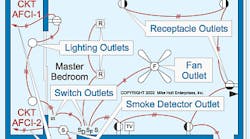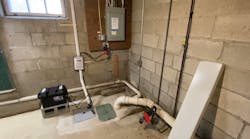Code Quandaries is back, and Mike Holt, EC&M's NEC Consultant, is here to answer your most difficult questions. Need some help with an installation? Clashing with your local inspector? E-mail Mike with a description of the situation at [email protected], and your question may show up in a future column.
Q.
When must you install the wiring of a 70V distributed sound system in a raceway? Based on Art. 725, I understand that if the amplifier output exceeds 100W, the wiring is classified as a Class 1 Remote-Control and Signaling Circuit and must be installed using a Chapter 3 wiring method.
A.
The amplifier must be marked with the output wiring method for sound systems, which is typically “Class 2 Wiring” [640.9(C)]. Class 2 wiring need not be installed in a raceway, but it must be installed in accordance with Art. 725. However, Class 2 cables installed in air-handling spaces, such as above a suspended ceiling used for environmental air, must be either plenum rated or installed in a metal raceway (725.61).
Q.
When can electrical nonmetallic tubing (ENT) be stubbed out in a drop ceiling? The building in question is three stories, and the ceiling in the hallway is regular T-bar.
A.
ENT is permitted in walls, floors, and ceilings — including suspended ceilings — in buildings not exceeding three stories [362.10(2)(1)(b) and 362.10(5)]. In buildings exceeding three stories, ENT may only be installed within walls, floors, or ceilings that provide a thermal barrier with at least a 15-min finish rating [362.10(2)]. ENT is permitted above a suspended ceiling in buildings taller than three stories if the suspended ceiling provides a thermal barrier with a 15-min finish rating [362.10(5)].
Exceptions to the two above rules permit ENT exposed in buildings — including above suspended ceilings — where a fire sprinkler system is installed in the building in accordance with NFPA 13-1999, Standard for the Installation of Sprinkler Systems.
The Code doesn't allow you to install ENT in ducts, plenums, or other air-handling spaces (300.22).
Q.
An inspector told me that 3- or 4-way switches are required in rooms with more than one entry or exit, but I haven't been able to find reference to this anywhere in the Code. Is the inspector right?
A.
The NEC doesn't specify the switch location for room lighting outlets, nor does it require 3- or 4-way switches to accommodate multiple room entries or exits. This is an issue left to the designer, not the electrical inspector.
Q. Do you have to use an AFCI with branch circuit wiring for smoke detectors located in dwelling unit bedrooms?
A.
All branch circuits supplying 15A or 20A, single-phase, 125V outlets installed in dwelling unit bedrooms must be AFCI-protected by a device listed to protect the entire circuit from an arc fault. Therefore, AFCI protection is required for the branch circuit wiring for smoke detector outlets [200.12(B)].
Q.
Due to space restrictions, I installed a 45kVA transformer above a suspended ceiling used for environmental air. The installation adheres to the requirements contained in 450.13(B), which specifies that dry-type transformers not exceeding 50kVA may be installed in hollow spaces of buildings not permanently enclosed by a structure. The electrical inspector rejected the installation because the transformer wasn't listed for use in the environmental air space (plenum rating). I couldn't find a transformer classification for this condition in the UL Green Book. Does the NEC require transformers installed in environmental air spaces to be listed for plenum applications?
A.
No, the NEC doesn't require transformers to be plenum rated or listed for use in an environmental air space. They just need to be installed in a metal enclosure, ventilated or non-ventilated [300.22(C)(2)]. For more information, review the NEC Handbook comments to 450.13(B), on page 578.
Q.
How much working space is required between a 120/208V distribution panel and a 277/480V transformer on the opposite side of the room?
A.
The working space requirement contained in 110.26 only applies to equipment that is likely to require examination, adjustment, servicing, or maintenance while energized (110.26). This is a judgment call for the authority having jurisdiction (AHJ). I personally would require the working space be a minimum of 4 ft deep by 30 in. wide, in accordance with 110.26(A)(1) and (A)(2).
The depth of the working space is measured from the enclosure front, and it may not be less than the following:
Condition Two.
Exposed live parts on one side and grounded parts on the other side of the working space. For the purpose of this table, concrete, brick, or tile walls are considered grounded.
Condition Three.
Exposed live parts on both sides of the working space.
The working space must be a minimum of 30 in. wide, but never less than the width of the equipment. In all cases the working space must be of sufficient width, depth, and height to permit at least a 90° opening of all equipment doors.
Q.
Does the NEC require all receptacles downstream from a GFCI receptacle to be marked “GFCI protected”? I thought I read this somewhere in the NEC.
A.
The “GFCI Protected” marking is only required where a nongrounding type receptacle has been replaced with a grounding type receptacle that is GFCI protected in a location where no grounding means exists in the outlet box. Under this condition all of the grounding type receptacles must be marked “GFCI Protected No Equipment Ground” [406.3(D)(3)].
Q.
A majority of information technology circuits (wiring under raised floors of data process equipment rooms) that I've come across aren't secured in place; they're laid under the raised floor in liquidtight conduit. Is this practice allowed per the requirements of the NEC?
A.
No. Branch circuit conductors within a raised floor shall be securely fastened in place in accordance with 300.11 [645.5(D)(2)]. However, power cables and associated boxes, connectors, plugs, and receptacles listed as part of information technology equipment don't need to be secured in place [645.5(E)].
Q.
We've been purchasing power whips made from liquidtight conduit with boxes listed for use with information technology equipment. We do this to get away from having to secure liquidtight in place. We haven't run into any problems yet, but I thought I would run it past you to see what you think. What are your thoughts?
A.
Because the wiring method is listed as part of information technology equipment, it isn't required to be secured in place [645.5(E)].





